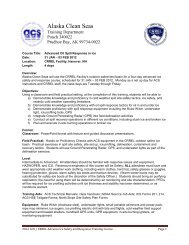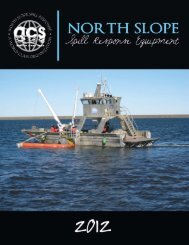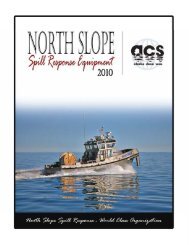(ACS) Technical Manual - Alaska Clean Seas
(ACS) Technical Manual - Alaska Clean Seas
(ACS) Technical Manual - Alaska Clean Seas
- No tags were found...
You also want an ePaper? Increase the reach of your titles
YUMPU automatically turns print PDFs into web optimized ePapers that Google loves.
TACTIC C-9 Exclusion Booming on River (Page 1 of 2) Exclusion Booming on River (Page 2 of 2) TACTIC C-9NOTE: “Base Location” is storage location (may change seasonally); “Mobe Time” is time to get it out of storage, prepare it foroperation, and make it ready to travel (concurrent for all equipment); “Deploy Time” is time to make it operational for its intended useat the spill site. These times do not include travel time from base to spill site, which may have multiple components (see Tactic L-3).CurrentShoreWest ChannelOptional AnchorsIslandEQUIPMENT AND PERSONNEL• Select vessels and boom according to area, water depth restrictions, and function (see Tactic L-6). Specific personnelrequirements depend on the length and type of boom and the nature of the area.IslandBoomand/orEQUIPMENTBoomBASELOCATION<strong>ACS</strong>, GPB, KRU, Endicott,AlpineFUNCTIONPIECES# STAFFPER SHIFTMOBETIMEExclusion booming >50 ft 3 1 hrShore Seal Boom <strong>ACS</strong>, KRU, MPU, Alpine Exclusion booming >50 ftDEPLOYTIME3 hr1 hr 1.5 hrEast ChannelIslandWork Boat All Booming support 1 1 hr 3 hr4Floating Pump and <strong>ACS</strong>, KRU, MPU, Alpine Shore Seal inflation 1 1 hr1.5 hrBlowerIslandAnchor System All Anchoring boom Variable 2 1 hr 3 hrTOTAL STAFF FOR SETUP >5Conventional BoomShoreline ProtectionCross-SectionAir ChamberWater ChamberShore Seal BoomShoreEQUIPMENTAvgas TrailerBASELOCATION<strong>ACS</strong>, GPB, KRU,Badami, AlpineSUPPORTFUNCTIONPIECES# STAFFPER SHIFTMOBETIMEDEPLOYTIMEAirboat fuel 1 1 (initial) 1 hr 0.5 hrMechanic Support All Support equipment 1 1 1 hr 0.5 hrWaterShore Seal BoomBackwater or EstuaryDEPLOYMENT CONSIDERATIONS AND LIMITATIONS• 8x6 Delta boom is most commonly used for this tactic.• Since the speed of the current perpendicular to the boom must be maintained at 3/4 kt or less, the length of boomneeded to stretch across a stream depends on the current. For a stream 100 ft across with a 1 kt current, a boomapproximately 140 ft long is needed. If the current is 2 kt, the same stream would require 320 ft of boom.• The speed of the current is not equal across the stream; the fastest water is with the deepest water. Oil movingin a stream will be entrained in the fastest water.• Don’t assume 100% containment with one boom system.• Readjust angles and widths between boom sections as current and wind change. Constantly monitor nearshoreboom systems to prevent escape of oil.CurrentEither conventional boom or a Shore Seal boom can be used to exclude oil from a sensitive area. For example, theShore Seal boom can be used in shallow water to boom off a backwater, or a conventional boom can be placedacross the mouth of a side channel to keep oil out. In addition, Shore Seal boom can be connected to conventionalboom to protect the shoreline.• Approval from the Operations Section Chief is required for any vehicle tundra travel (off-road or off-pad), whichmust be in accordance with <strong>ACS</strong>’ emergency tundra travel permit (See Tactic A-3). Any excavations in tundra orany tundra damage must be reported to the Operations Section Chief. All on-tundra activity must be documentedand reported to the Planning Section for reporting to ensure permit compliance. Avoid archeological sites andbiologically sensitive habitats. Travel across tundra with tracked vehicles, heavy equipment, and even foot trafficcan seriously damage the vegetative mat, induce thermokarst, and cause structure disturbance. Using sheets ofplywood as a traveling surface and minimizing trips with equipment greatly reduce disturbance of the tundra.<strong>ACS</strong> Tech. <strong>Manual</strong> Vol. 1, 03/12 NOTE: All values given on these pages are for planning purposes only.NOTE: All values given on these pages are for planning purposes only. <strong>ACS</strong> Tech. <strong>Manual</strong> Vol. 1, 03/12






